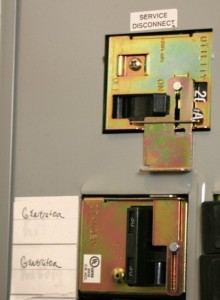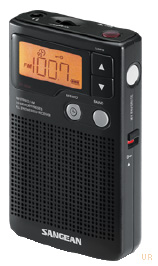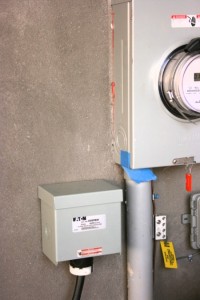Google has once again featured a radio-related theme–this time (unfortunately!) as an April Fool’s joke. This video will explain it all:
Category Archives: Funny
My New Year’s preparedness test
Last year, we published two popular articles on preparedness. As I mention in the articles, I’m no hard-core survivalist, but I certainly believe in being prepared.
This year, on New Year’s day, I got tested. Big time. Here’s what happened:
We had planned a New Year’s day lunch for twelve, which meant quite a bit of food preparation. I was chef for the day. At 11:00 am, right after I had just begun searing a large pork roast with the intention of cooking it in the pressure cooker, the lights went out. I thought perhaps a circuit breaker had tripped. One glance at the power meter, though, and I knew there was no electricity on tap.
So–although we’re not talking life and death here–I had a huge, raw (and frankly expensive) hunk of locally-raised pork to prepare, not to mention all the vegetables I intended to cook; no lights; no water (i.e., no toilet flushing); no auxiliary heat–and a herd of guests, all of whom had driven at least an hour’s distance, en route and looking forward to a delectable dinner. I didn’t even have time to call the power company to report the power failure. What’s more, as we live in the middle of nowhere, in a best-case scenario it would take the company at least two hours to get here…and on New Year’s Day?
But I try to practice what I preach.
I have a 5550 Watt portable Genrac generator that we use in case of power failure –mainly to supply power to our water pump, lights, and a few appliances (like a microwave). It’s at least six years old, but works beautifully for those modest energy requirements. BUT: I had never tested the generator with the stove top. And looking at my raw dinner, and at the clock, I decided I was going to. No way was my nice cut of pork going to be crammed into our microwave.
So I washed my hands, and zipped around the house turning off all unnecessary power loads and sensitive equipment (radios, computers, router, modem, lights, etc.). I then stepped outside, poured about two gallons of gas from the 10-15 gallons I keep on hand for emergencies into my generator, and fired her up. Though this unit doesn’t have electronic ignition, it did start almost immediately, because I test it every couple of months.
I plugged the generator into our breaker box via an external junction and 12′, 240V cord that we had installed by a certified electrician earlier this year. This system included a fail-safe switch that forces us to disconnect our house from the grid, prior to permitting the generator to do its job (lest our power hurt someone working on the power lines).
I flipped the switch, walked back into the house, and saw that the generator had restored our lighting. Still, the lingering uncertainty in my mind was, “Will the generator power the stove’s burner so that I can at least cook the pork and veggies?” I listened to the generator hum as I turned the burner dial on…it barely strained. Whew!

This switch, located on our breaker box, prevents the generator from being connected to the house while the grid is connected.
Over the course of the next hour, guests started arriving; I continued to cook as if we had grid power. It was amazing. Everyone looked a little puzzled when they drove up and heard the generator running, but inside, found us enjoying lights, music, warmth, and the delightful aroma of the succulent pork and apples. Happily, the meal went off without a hitch.
Mind you, I don’t think the generator could have handled the load of the water pump and the stove top if we didn’t have solar hot water and passive solar heating. An electric furnace and electric hot water heating elements in a traditional water heater would have simply been too much of a load.
So what’s my point?
I know people who go through a nasty power outage and say, “never again!” They either:
- Install an extremely expensive automatic propane or diesel backup generator
- Buy a portable generator like mine, but fail to keep spare fuel on hand, or to test it on occasion
Obviously, neither is ideal.
Preparedness is as much about testing and understanding the limits of what you have–running a few “real-life” scenarios to flesh out anything you might overlook in an actual outage–like fuel, a non-functioning generator, power cords, etc.
And my radios? Not only will the generator power all of my tabletop receivers and ham radio transceivers, but I keep a separate 40 aH sealed battery fully charged, and at-the-ready, at all times.
After all, every seasoned radio hobbyist who lives in a populated area knows that the best and quietest conditions for catching a little DX is when all of your neighbors’ power is out!
Always keep spare batteries and power for your radios when the grid fails. Don’t just do it for preparedness’ sake, do it for your listening ears!
Happy New Year, and 73s, friends!
How to turn your AM radio into a metal detector

Really? This radio could find a missing toy?
While watching Curious George on PBS Kids with my four year old, I learned something. In the episode we viewed–“Curious George, Metal Detective”–George needs a metal detector to find a toy robot he’s lost in the sand, but the one he’s borrowed has run out of batteries. “How about making one?” his scientist friend suggests. Make one? “It’s easy,” she explains: simply by taping an AM radio and calculator together, you can make your own metal detector. George tries it, and–lo and behold–finds his missing toy.
Really? I wondered. Was this PBS show feeding my skeptical children science fiction?
I quickly googled the notion, and apparently, it works! Watch the video below for a tutorial on building your own deluxe model:
Lessons learned? You’re never too old to learn from Curious George, PBS, or the fellow in this video. And radios are clearly even more versatile than even I guessed.
Now, back to metal detecting…Is that another soda can?
Pirate Radio and Hurricane Irene
 Last night, I tuned to the pirate radio watering hole of 6,925 kHz shortwave. I caught a bit of the Southern Relay Network as they played several hurricane and storm themed songs.
Last night, I tuned to the pirate radio watering hole of 6,925 kHz shortwave. I caught a bit of the Southern Relay Network as they played several hurricane and storm themed songs.
I recorded a bit of the end of the show for you. Note that there was a lot of noise on the frequency–many of the static crashes were attributed to Hurricane Irene herself.
Click here to download/play the mp3 file, use the archive.org flash player below (if visible) or simply visit the archive.org audio page. Enjoy!
Radio used, by the way, was the Alinco DX-R8T. We will be posting a review of this receiver, so check back soon!
Jonathan Marks re-publishes “The Hitch-Hikers Guide to DXing”
 Jonathan Marks has re-released The Hitch-Hikers Guide to DXing. In his own words:
Jonathan Marks has re-released The Hitch-Hikers Guide to DXing. In his own words:
It is thirty years ago since I wrote a rather silly parody on both international radio broadcasting based on my favorite radio series at the time, the Hitch-Hikers Guide to the Galaxy. There seemed to be so much to make fun of at the time…the boring propaganda at the height of the Cold War, jamming, the waste of energy shouting from one country to another, and the variable quality of reaction from listeners. I don’t think it was the listeners’s fault that most of the feedback was very technical, to do with signal strength and QSL cards rather than comments on the programme. May be people were being too polite.
[…]There wasn’t much time to write radio drama on the second floor of the Radio Netherlands building. And there was no budget to hire actors. So I just rattled it off on a typewriter and asked colleagues to come and read their parts in a lunchtime recording session. This was all two track material, sliced together with a chinagraph pencil and a razor blade. In total we made 5 in 1981 to fit the 5th Thursday in the month, and then one more in 1982 as a Christmas special.
To listen to all five episodes, simply cruise to the Media Network Vintage Vault and start with Episode 1. It’s well worth a listen and a nice little piece of 1981 RNW ingenuity.


